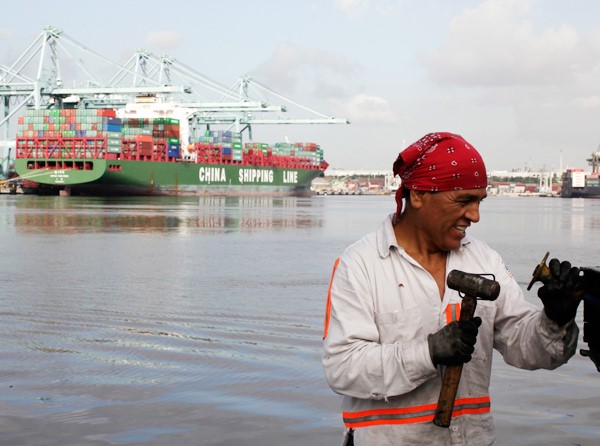Shipping industry being buoyed by China data
The international shipping sector is banking on forecasts that predict growth in the China-led trade of commodities to create an increasingly integrated global infrastructure for services.
 On Tuesday, Ben Line and Sharaf, two shipping agencies operating in Asia and the Middle East respectively, created a joint venture called Water-Front Maritime Services for clients requiring new global trade routes.
On Tuesday, Ben Line and Sharaf, two shipping agencies operating in Asia and the Middle East respectively, created a joint venture called Water-Front Maritime Services for clients requiring new global trade routes.
"Seaborne trade is becoming increasingly international in nature in recent years and China is the key driver, as the volume of Chinese trade with other continents significantly grew since it joined the World Trade Organization," said Terry Gidlow, CEO of WaterFront Maritime Services.
"Demand for integrated solutions in serving shipping clients, from trade origin to destination, is crucially important in today's market to cut costs, time, and ensure regulatory and legal compliance."
Other recent examples of integration include Hapag-Lloyd's merger with United Arab Shipping Company, CMA CGM purchasing Neptune Orient Lines, and the merger of Mitsui OSK, K Line and NYK.
The integration comes as President Xi Jinping has spoken in support of globalization, and the China-led Belt and Road Initiative has gained traction. Industry analysts said both factors contributed significantly to the growth of cross-regional service integration and forecast shipping volume.
"The Belt and Road Initiative is possibly the largest and most exciting transport and infrastructure program in modern times," said Harry Theochari, global head of transport at law firm Norton Rose Fulbright.
"The shipping of commodities and engineering materials will greatly increase the current demand for all types of shipping."
Sluggish economic growth globally trigged a downturn in shipping in the years after the financial crisis, but the latest data shows signs of recovery, with Chinese imports of commodities acting as a driver.
According to statistics from China's General Administration of Customs, the nation's imports of iron ore in the first half of 2016 reached 494 million metric tons, an increase of 9.1 percent year-on-year.
China's imports of crude oil reached 187 million tons, up 14.2 percent. Its coal imports hit 108 million tons, up 8.2 percent. And its copper imports reached 2.74 million tons, an increase of 22 percent.
And the potential is even greater, given that Chinese companies have invested in infrastructure projects worth more than $50 billion to foster trade among countries along the Belt and Road trade routes.
Theochari said shipping companies that survived the recession are "very well placed to benefit from the likely huge increase in demand for shipping which will be driven primarily by demand created by China's desire to cement its position as a true global superpower".

"Seaborne trade is becoming increasingly international in nature in recent years and China is the key driver, as the volume of Chinese trade with other continents significantly grew since it joined the World Trade Organization," said Terry Gidlow, CEO of WaterFront Maritime Services.
"Demand for integrated solutions in serving shipping clients, from trade origin to destination, is crucially important in today's market to cut costs, time, and ensure regulatory and legal compliance."
Other recent examples of integration include Hapag-Lloyd's merger with United Arab Shipping Company, CMA CGM purchasing Neptune Orient Lines, and the merger of Mitsui OSK, K Line and NYK.
The integration comes as President Xi Jinping has spoken in support of globalization, and the China-led Belt and Road Initiative has gained traction. Industry analysts said both factors contributed significantly to the growth of cross-regional service integration and forecast shipping volume.
"The Belt and Road Initiative is possibly the largest and most exciting transport and infrastructure program in modern times," said Harry Theochari, global head of transport at law firm Norton Rose Fulbright.
"The shipping of commodities and engineering materials will greatly increase the current demand for all types of shipping."
Sluggish economic growth globally trigged a downturn in shipping in the years after the financial crisis, but the latest data shows signs of recovery, with Chinese imports of commodities acting as a driver.
According to statistics from China's General Administration of Customs, the nation's imports of iron ore in the first half of 2016 reached 494 million metric tons, an increase of 9.1 percent year-on-year.
China's imports of crude oil reached 187 million tons, up 14.2 percent. Its coal imports hit 108 million tons, up 8.2 percent. And its copper imports reached 2.74 million tons, an increase of 22 percent.
And the potential is even greater, given that Chinese companies have invested in infrastructure projects worth more than $50 billion to foster trade among countries along the Belt and Road trade routes.
Theochari said shipping companies that survived the recession are "very well placed to benefit from the likely huge increase in demand for shipping which will be driven primarily by demand created by China's desire to cement its position as a true global superpower".
time
2017-03-23 14:56
column
Mac information
author
admin
